 |
| U.S. Fish and Wildlife biologist with a rare bird |
Saturday was mostly cloudy, cold (high of 40 degrees F in the afternoon) and windy. As we waited for the bus to depart, the group endured snow squalls.
Northern Delaware is DuPont territory. Many of the wealthy heirs of the DuPont chemical fortune established expansive estates in the rolling hills of Delaware's Piedmont west of Wilmington, and some of these were sites we visited. Our first stop was Mt. Cuba, a 500-acre estate that has been turned into a botanic garden featuring plants native to the Piedmont. The 50 acres surrounding the mansion are a horticultural showplace and are beautifully maintained, but the remainder of the property (the part our group visited) faces the same challenges I face at my preserve: overabundant deer, invasive plants, and stream flooding.
 |
| Nathan Shampine, Mt. Cuba's natural lands manager, indicating that deer could gain access to this fenced exclosure |
 |
| The golden rolling hills of northern Delaware's Piedmont in early spring |
 |
| A Red-winged Blackbird's epaulet (Agelaius phoeniceus) found on the ground |
Our second stop was the Delaware Nature Society's Coverdale Farm and Burrow's Run preserves. At Coverdale Farm, we explored a wetland restoration project in which a wet cattle pasture formerly drained by terracotta tile pipes had been reflooded (by removing and breaking the pipes) in order to provide habitat for federally endangered bog turtles (Clemmys muhlenbergii).
 |
| The wetland created by re-flooding the field--a sedge hammock marsh |
 |
| The re-engineered outlet from the marsh (still a bit raw) |
Our group continued walking to the adjacent Burrow's Run Preserve, where the Delaware Nature Society has been converting pastures to native grasslands for grassland-nesting birds. I literally was in awe and very jealous of their best fields, pictured below. These fields support moderate growth of little bluestem grass (Schizachyrium scoparium) interspersed with dozens of species of forbs (i.e., wildflowers) - exactly the type of habitat meadow-nesting birds are seeking. The grasses provide cover and the forbs attract insects for the birds to eat. The fields at my preserve, in contract, are almost exclusively grassy with few forbs, which is why we haven't had luck attracting birds to my fields.
 |
| Beautiful native meadows |
 |
| Queen Anne's Lace (not native) against gray skies |
 |
| A renovated barn on the Flintwoods estate |
 |
| Flintwoods' land manager explaining how he intends to modify his management plan for his grasslands this year |


6 comments:
Another fascinating, informative post, Scott, replete with great photos. I like the pic of Queen Anne's Lace. That is one heck of a handsome barn; obviously there were ample funds for the renovation.
I must confess, Packrat, that another member of our field trip started to take images of the Queen Anne's Lace against the sky, and then I jumped in and copied her. I wish that I had the "eye" some photographers have developed.
There's no shortage of money in Flint household. I mean, how many people can make a "living" repairing vintage baroque harpsichords?
Maybe some day when Leah and I win the huge lottery jackpot we'll be able to have a mega-estate with a nature preserve on it. I think I would like that. I think.
Great photos and a wonderful field trip. Love seeing the east coast through your eyes.
Mark: You'd need a huge lottery jackpot so that you could pay someone (or some people) to take care of the place for you!
Thank you, Robin Andrea. The native grasslands about which I was so excited just kept eliciting comments from me to the other field trip participants of "These fields are so beautiful! and "These fields are nearly perfect!"
Post a Comment